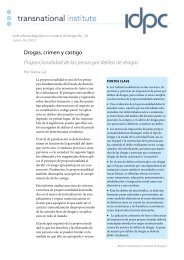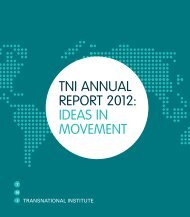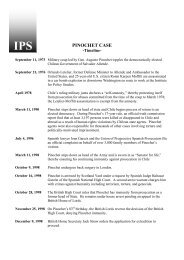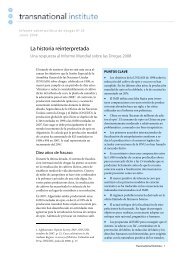Rethinking Privatization Towards a Critical Theoretical Perspective
Rethinking Privatization Towards a Critical Theoretical Perspective
Rethinking Privatization Towards a Critical Theoretical Perspective
You also want an ePaper? Increase the reach of your titles
YUMPU automatically turns print PDFs into web optimized ePapers that Google loves.
generic expression for a range of private sector involvementsin service delivery rather than a single state ofbeing. This is done in part because the term privatisationis widely recognised in popular discourse (as opposed to‘public-private partnerships’) and in part because it highlightsthe fact that assets and/or decision making responsibilitieshave passed from public to private hands.But we cannot limit our discussion of privatisation todirect private sector participation and control. Equallyimportant is the question of private sector operatingprinciples and mechanisms. The ‘commercialisation’ ofservices in the formally designated public sector is criticalto our understanding of public services reforms. Thenext section describes commercialisation (and its mostcommon institutional variant, ‘corporatisation’) and discussesits links – mechanically and conceptually – to privatisation.The meanings of commercialisationand corporatisationCommercialisation refers to a process by which marketmechanisms and market practices are introduced intothe operational decision making of a public service – e.g.profit maximisation, cost recovery, competitive bidding,cost-benefit analysis, performance targeted salaries,ringfenced decision making, demand-driven investments,etc. (Stoker, 1989; Pendleton and Winterton,1993; Dunsire, 1999; Leys, 2001; Olcay-Unver et al,2003). This is in opposition to the more traditional publicsector operating principles of integrated planning,(cross) subsidisation, supply-driven decision making,equity orientation, and so on (keeping in mind that thereare no ideal or absolute types here – i.e. commercial principlesand more traditional public sector managementprinciples can run concurrently, to varying degrees).A popular institutional form of commercialisation iscorporatisation, where services are ringfenced intostand-alone ‘business units’ owned and operated by thestate but run on market principles. Corporatisationinvolves two major organisational shifts. The first entailsfinancial ringfencing, whereby all resources directlyinvolved in the delivery of a service are separated from allother service functions (e.g. personnel in water are separatedout for accounting purposes from personnel inwaste management and are not allowed to do work forthe other unit). Where resources are shared by more thanone department (e.g. information technology, vehicles)the ringfenced entity pays the other unit a full-cost fee forthe use of those resources (see Shirley, 1999; PWC, 1999;PDG, 2001; Whincop, 2003; Bollier, 2003).The purpose of this financial ringfencing is to createa transparent form of accounting where all costs and revenuesrelated to the service can be identified, along withany subsidies in and out of the ringfenced unit. This isintended to reveal the real costs/surpluses of running aservice and allows managers to identify areas of financialloss/gain that may have otherwise been hidden in theintricate accounting systems and cross-subsidisationmechanisms of an integrated service delivery schemewith centralised accounting. Financial ringfencing alsocreates an opportunity to introduce financially drivenperformance targets for managers (i.e. managers arerewarded for meeting loss/profit targets). This approachintroduces market-based salaries for managers with theaim of attracting ‘world class’ executives who are expectedto pay their way by ensuring that the bottom line ispositive.The second aspect of corporatisation is managerialringfencing – the creation of separate business unitsmanaged by appointed officials operating at arms lengthfrom the public authority. Elected officials still set standardsand service delivery goals for a corporatised serviceunit, as well as monitor and evaluate its activities, butthe daily management and long-term planning of theunit are done by the ringfenced management team.What is the link between corporatisation and privatisation?First and foremost is the change in managementethos with a focus on a narrow and increasingly shorttermfinancial bottom line. So complete can this shift inmanagement culture be that utilities and services whichare fully owned and operated by the state (i.e. consideredto be fully ‘public’) can be more commercial than their‘privatised’ counterparts, with managers aggressivelypromoting and enforcing cost recovery and other marketprinciples.Second, corporatisation often promotes outsourcingas an operating strategy and discreet form of cost-cutting.A competitive operating environment, in turn,requires deregulating (or re-regulating) monopolisticcontrol of the service and allowing multiple serviceproviders to compete with the ringfenced unit to providea particular service at cost-effective prices (e.g. meterreading). The removal of subsidies, for instance, forcesstate-owned enterprises to compete for finance on anequal basis with private firms or other corporatised enti-12
















